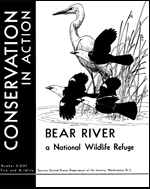United States Fish and Wildlife Service

United States Fish and Wildlife Service: Publications
Date of this Version
2002
Abstract
The Biomonitoring of Environmental Status and Trends (BEST) program identifies and evaluates the effects of environmental contaminants on lands and biological resources managed by the Department of the Interior (DOI). The primary goals of the BEST program are: 1) determine the status and trends of environmental contaminants and their effects on biological resources, 2) identify, assess, and predict the effects of contaminants on ecosystems and biological populations, and 3) provide summary information to managers and the public for guiding conservation efforts. One tool used to reach these goals is the Contaminant Assessment Process (CAP). CAP is a two-part process involving a retrospective analysis of existing information to assess contaminant threats to lands managed by DOI bureaus. On refuges, this analysis is conducted by the U.S. Fish and Wildlife Service and funded by BEST. Secondly, if a likely or suspected contaminant issue is identified in the first part of the CAP process, sampling is conducted to confirm the presence of contaminants or their effects.
The retrospective analysis involves reviewing existing documentation and spatial information for the land unit of interest. Contaminant sources and pathways (i.e. rivers, prevailing wind direction, ground water) are identified. Contaminants of concern (COCs) and potentially sensitive species are described. Areas of likely contamination within the land unit are defined and ranked. The findings are summarized in a preliminary report. If warranted, field sampling is conducted to further evaluate potential threats. Field sampling is of a confirmatory nature, designed to determine if contaminants are present or causing an effect on resources.
Another purpose of the CAP is to identify lands that may be vulnerable to spills of hazardous substances. Once these areas are identified, resources (soils, water bodies, biota) can be targeted for collection of baseline data to support any future natural resource damage assessments.
In 1996, the U.S. Fish and Wildlife Service, Colorado Field Office, Environmental Contaminants Program, Lakewood (CFO) initiated and completed the retrospective analysis of CAP for the Arapaho National Wildlife Refuge (Refuge). In 2001, the retrospective analysis was updated by the CFO using a geographic information system (GIS). The retrospective analysis identified contaminant sources and transport pathways to the Refuge. The contaminant sources and types were prioritized, and areas of potential contamination within the Refuge were delineated. This report summarizes these sources and areas of potential contamination. Spatial and tabular information were incorporated into the CAP and were managed using a GIS. Data were collected from federal and state databases (Appendix A). The products of this assessment include this report and the GIS project that incorporates all information collected.


Comments
Published in Arapaho NWR CAP Narrative, 1-89, (2002)